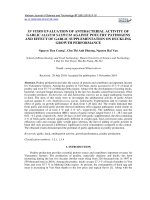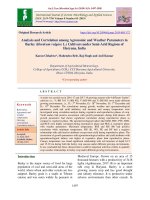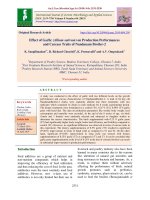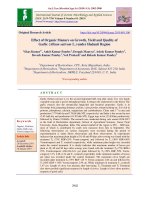Genetic variability and correlation studies in garlic (Allium sativum L.)
Bạn đang xem bản rút gọn của tài liệu. Xem và tải ngay bản đầy đủ của tài liệu tại đây (299.91 KB, 6 trang )
Int.J.Curr.Microbiol.App.Sci (2020) 9(5): 358-363
International Journal of Current Microbiology and Applied Sciences
ISSN: 2319-7706 Volume 9 Number 5 (2020)
Journal homepage:
Original Research Article
/>
Genetic Variability and Correlation Studies in Garlic (Allium sativum L.)
S. V. Sable1, D. T. Deshmukh2*, S. M. Ghawade3 and S. S. Rawat1
1
Department of Agricultural Botany, 2Directorate of Research (Seed),
3
Chilli and Vegetable Research Unit, Dr. Panjabrao Deshmukh Krishi Vidyapeeth,
Akola – 444104, Maharashtra, India
*Corresponding author
ABSTRACT
Keywords
Genotypes of garlic
environment
neck thickness
Article Info
Accepted:
05 April 2020
Available Online:
10 May 2020
Eleven genotypes of garlic were evaluated for genetic variability and correlation for fifteen
quantitative traits. The magnitude of phenotypic coefficient of variation was found greater
than the corresponding genotypic coefficient of variation for all the characters indicating
the importance of environment in expression of characters. High estimates of heritability
(broad sense) coupled with high genetic advance as percentage of mean were observed
for number of cloves per bulb, leaf length (cm), neck thickness (cm) and average weight of
dry bulb (g) indicating preponderance of additive genetic variance, which could be
exploited through selection for the improvement of these characters. The positive and
significant genotypic correlation of plant height, neck thickness, polar diameter of clove,
equatorial diameter of clove, number of cloves per bulb, average weight of 10 clove,
average weight of fresh bulb with yield per plot and their significant correlation among
them revealed its importance while selection during breeding programme.
thousand tonnes with productivity of 5.4 t/ha.
(Anon, 2016) Madhya Pradesh is a leading
state accounting for 21.17 thousand hectares
with 424.50 thousand tonnes of production
followed by Gujarat, Uttar Pradesh and
Rajasthan (Anon, 2015).
Introduction
Garlic (Allium sativum L.; 2n=16), is an
important spice crop belongs to the family
Alliaceae. Garlic contains average 59-78%
water, 6 % protein, 0.5 % liphid, 33 %
carbohydrates, 2% fibre, 1 % sugar and
volatile oil known as diallyl disulphide which
is the major flouring component in garlic. The
area and production of India under garlic crop
during 2015-16 was reported to be 262.04
thousand hectares and production 1425.46
In Maharashtra, it is grown on 3500 ha area
with the production 40000 tonnes. The
presence of local types with the farmers and
it’s adaption on their field imposes the scope
for varietal breeding with wider adaptability
358
Int.J.Curr.Microbiol.App.Sci (2020) 9(5): 358-363
and high yield. Therefore, in present studies
selection made from local types were
evaluated for their variability and to estimates
inherent
association
between
genes
controlling two characters. The inferences of
the studies could help the breeder for genetic
improvement in garlic.
Results and Discussion
Any breeding programme of genetic
improvement requires basic information
regarding the genetic variability present in the
crop. Correlation studies help the breeder for
selection of the other characters which has a
significant association with yield .The
analysis of variance revealed significant
difference among the genotypes for all traits
studied. The phenotypic coefficient of
variation (PCV), genotypic coefficient of
variation (GCV), heritability (h2) in broad
sense, genetic advance (GA) and genetic gain
as per cent of mean for various characters are
presented in Table 1. The results indicated
that phenotypic variance were higher than the
genotypic variance indicating the influence of
environment.
Materials and Methods
The experimental material comprised of
eleven genotypes of Garlic , Which includes
eight lines selected from local viz., AKG-1,
AKG -2 , AKG -3 , AKG-4, AKG-5 , AKG-6,
AKG-7 , AKG -8 and three checks Viz., G-4,
Godawari and G-282. These genotypes were
evaluated in Randomized Block Design at
Chilli and Vegetable Research Unit, Dr.
PDKV, Akola (Maharashtra) during Rabi
season 2016-2017. Each genotype was grown
in one plot of 3.20 X 1.50 m2 length in each
replication with the spacing of 10 X 10 cm.
The phenotypic variation based on mean
values is not the precise criterion to estimate
extent of variability therefore better index for
measuring the genetic variability is genotypic
coefficient of variation (GCV) as described
by Burton (1952). The highest GCV was
recorded in Number of cloves per bulb (29.42
%) followed by neck thickness (14.68 %),
Average weight of dry bulb (13.94 %),
Average weight of 10 cloves (12.66%) and
leaf length (12.63%). The estimates of
heritability in broad sense were very high to
high for Number of cloves per bulb (91.87%),
Leaf width (87.18%),
The observation were recorded on five
randomly selected plants of each genotype in
each replication for fifteen characters viz.,
Plant height at maturity(cm), Number of
leaves per plant, Neck thickness ( cm), Leaf
length (cm), Leaf width (cm), Polar diameter
of bulb (cm), Equatorial diameter of bulb
(cm), Polar diameter of clove
(cm),
Equatorial diameter of clove (cm), Number
of cloves per bulb, Average weight of 10
clove(g), Average weight of fresh bulb(g),
Average weight of dry bulb(g), TSS (%) and
yield per plot (kg). Analysis of variance was
done as per the methodology suggested by
Panse & Sukhatme (1988). The genetic
parameters viz., genotypic and phenotypic
coefficient of variation, heritability (broad
sense) and genetic advance were estimated
using the formulae suggested by Burton
(1952) and Lush (1949). The genotypic
correlation coefficients were calculated as per
method suggested by Johnson et al., 1955.
Average weight of dry bulb (70.56 %).
Whereas, it was moderate for yield per plot
(68.49 %), Nick thickness (68.19%) and leaf
length (62.08 %). The results were close
proximate to that of Singh et al., (2012).
Heritability values together with genetic
advance would be more useful in predicting
the response to selection (Johnson et al.,
1955). High heritability estimates coupled
with moderate to high genetic advance as
percent of mean (GAM) was recorded for
359
Int.J.Curr.Microbiol.App.Sci (2020) 9(5): 358-363
number of cloves per bulb (H2=91.87 %,
GAM= 58.09 %), average weight of dry bulb
(H2=70.56 %, GAM= 24.13), neck thickness
(H2= 68.19%, GAM=24.97 %) and leaf length
length (H2= 62.08 %, GAM= 20.50 %). The
results were closing proximate to that of
Vatsyayan (2013). Thus, the characters
number of cloves per bulb, average weight of
dry bulb, nick thickness and leaf length
which has exhibited high GCV %, high to
moderate heritability estimates coupled with
high to moderate genetic gain suggesting the
preponderance of additive genes and could be
exploited under selection in breeding
programme.
Table.1 Estimates of genetic parameters for the fifteen characters in garlic
S.
Characters
No.
GCV
PCV
h2
%
%
%
GA
GAM
%
1.
Plant height (cm)
6.38
11.05
33.29
4.43
7.58
2.
Number of leaves per [plant
4.29
7.66
31.35
0.45
4.94
3.
Neck thickness (cm)
14.68
17.77
68.19
0.22
24.97
4.
Leaf length (cm)
12.63
16.03
62.08
7.94
20.50
5.
Leaf width (cm)
6.80
7.28
87.18
0.19
13.08
6.
Polar diameter of bulb(cm)
4.36
7.57
33.12
0.14
5.16
7.
Equatorial diameter of bulb
3.80
5.85
42.18
0.18
5.08
(cm)
8.
Polar diameter of clove (cm)
6.33
9.28
46.6
0.15
8.90
9.
Equatorial diameter of clove
5.76
9.79
34.65
0.06
6.99
(cm)
10.
Number of clove per bulb
29.42
30.69
91.87
14.74
58.09
11.
Average weight of ten clove
12.66
19.42
42.53
3.58
17.01
7.63
12.51
37.25
2.14
9.59
13.94
16.60
70.56
4.66
24.13
(g)
12.
Average weight of fresh bulb
(g)
13.
Avrage weight of dry bulb
(g)
14
T.S.S. ( %)
5.54
9,02
37.66
2.76
7.00
15
Yield per [plot( Kg )
7.42
8.96
68.49
0.22
12.64
360
Int.J.Curr.Microbiol.App.Sci (2020) 9(5): 358-363
Table.2 Genotypic correlation coefficients among the fifteen characters
Characters
PH
NL
NT
LL
LW
PDB
ED B
PD C
ED C
NC B
AW 10 C
AW FB
AW DB
TSS
YP
PH
1.00
- 0.172
0.998**
-0.903**
-0.031
0.454
0.122
0.727**
0.627*
0.114
0.854**
-1.014
-0.330
0.179
0.918**
1.00
0.463
-0.005
0.648**
-0.484*
-0.766
0.306
-0.192
-0.106
-0.048
0.196
-0.132
-0.171
0.069
1.00
0.543
-0.299
0.531
-0.005
0.528*
0.991**
0.073
0.824*
-0.586*
-0.230
0.223
0.451*
1.00
-0.194
0.359
0.597
0.534*
0.636**
0.464*
0.295
0.051
0.237
0.124
0.229
1.00
-0.693**
-0.435
0.405
-0.174
-0.418
-0.152
-0.282
-0.721**
-0.707
0.087
1.00
0.030
0.096
0.749**
0.060
0.584*
-0.819**
0.088
0.925
0.321
1.00
-0.489
0.597*
0.619
-0.297
0.239
0.382*
0.137
-0.603**
1.00
0.707
-0.617*
0.389
-0.722
-0.523
0.099
0.532*
1.00
0.053
0.393*
-0.730*
-0.207
0.620*
0.989**
1.00
-0.038
0.754**
0.787**
-0.268
0.545*
1.00
-0.935**
-0.244
0.471
0.598*
1.00
-0. 926**
0.349
0.970**
1.00
0.805**
-0.484
1.00
0.193
NL
NT
LL
LW
PD B
ED B
PD C
ED C
NC B
AW 10 B
AW F B
AW D B
TSS
*= 5 % level of significance , ** = 1 % level of significance
Abbreviations used for characters:PH
: Plant height (cm)
ED C
: Equatorial diameter of clove ( cm)
NL
: Number of leaves perplant
NC B
: Number of clove per bulb
NT
: Neck thickness (cm)
AW 10 C : Average weight of 10 clove (g)
LL
: Leaf length
AW F B : Average weight of fresh bulb ( g)
LW
: Leaf width (cm)
AW D B : Average weight of dry bulb ( g)
PD B : Polar diameter of bulb ( cm)
TSS
: Total soluble solid ( % )
DB
: Equatorial diameter of bulb ( cm)
YP
:Yield per plot ( kg) .
PD C
: Polar diameter of clove ( cm)
361
Int.J.Curr.Microbiol.App.Sci (2020) 9(5): 358-363
The correlation coefficient indicates the
nature of association among the different
traits. The characters that are positively
correlated with yield are of considerably
important for plant breeder for selection
purpose. In present investigation ( Table 2 )
yield per plot has shown significant positive
correlation with plant height (0.918), neck
thickness (0.451), polar diameter of clove
(0.532), equatorial diameter of clove (0.989),
number of cloves per bulb (0.545), average
weight of 10 clove (0..598), average weight of
fresh bulb (0.970).
Burton, G.W. 1952. Quantitative inheritance
in grasses. Proc. Int. Grassland Congr.
6:277-283.
Dhall, R.K. and Brar ,P.S. 2013. Genetic
variability, correlation and path
coefficient studies in garlic (Allium
sativum L.) Vegetable science , 2 (2):
102-104.
Johnson, H.W., Robinson, H.F. and
Comstock, R.E. 1955. Estimates of
genetic and environmental variability in
soybean. Agronomy Journal, 47:314318.
Kohali, U.K. and Mahajan, Nutun .1993.
Yield performance and correlation
studies in Garlic. A note , Haryana
Journal of Horticulture Sciences . 22:
163-165 .
Lush, J.L. 1949. Intra-sire correlation or
regression offspring on dam as a
method of estimating heritability of
characteristics. Ann. Prod. Am. Animal
Prod., 33:293-301.
Panse, V.G. and Sukhatme, P.V. 1988.
Statistical methods for agricultural
worker, ICAR Publ., (II ed.), New
Delhi.
Rahman, A.K.M.M. and Das, M.K.1985.
Correlation and path analysis in garlic.
Bangladesh Journal of Agricultural
Research .10: 50-54.
Srivastava, B.P.,Dubey ,A.K. and Srivastava
,J.P. 1993. Genetic association and path
analysis in Garlic . Haryana Journal of
Horticultural Sciences. 22(1) 85-88.
Sonkiya ,A.K.,Singh ,P.P. and Naruka, I.S.
2012. Variability, character association
and path coefficient analysis in garlic .
Medicinal Plant .4(2) : 90-93.
Vatsyayan,S, Brar,P.S. and Dhall,PR.K. 2013.
Genetic variability studies in garlic
(Allum sativum L.). Annals of
Horticulture .6(2) : 315-320.
Moreover, these character also exhibited
positive and significant correlation among
themselves Viz plant height with neck
thickness (r =0.998), equatorial diameter of
clove (r = 0.627) and average weight of 10
clove (r = 0.857). Neck thickness with
equatorial diameter of clove (r = 0.991) and
average weight of 10 clove (r = 0.824).
Equatorial diameter of bulb with average
weight of 10 clove (r = 0.393). This resembles
to the finding of Srivastava et al., (1993),
Kohali anmd Mahajan (1993) Dhall and Brar
(2013), Rahman and Das (1985) and Sonkiya
et al., (2012).
Thus, the selection based on the characters
viz., plant height, neck thickness, polar
diameter of clove, equatorial diameter of
clove, number of cloves per bulb, average
weight of 10 clove, average weight of fresh
bulb could help in genetic improvement
programme in garlic.
References
Anonymous 2015. www.nhrdf.org.
Anonymous 2016. Spices Statistics at Glance
2016. By Directorate of Arecanut and
spices Development, GOI, Calicut
(Kerala).
362
Int.J.Curr.Microbiol.App.Sci (2020) 9(5): 358-363
How to cite this article:
Sable. S. V., D. T. Deshmukh, S. M. Ghawade and Rawat. S. S. 2020. Genetic Variability and
Correlation Studies in Garlic (Allium sativum L.). Int.J.Curr.Microbiol.App.Sci. 9(05): 358363. doi: />
363









